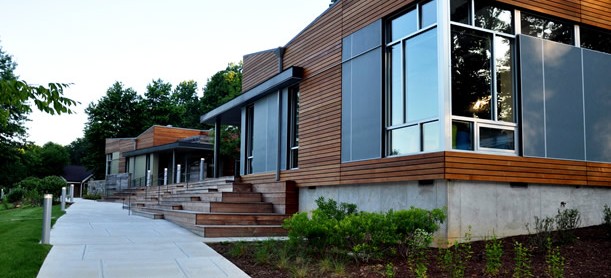Time is money, and constructing a conventional office building is time-consuming and expensive. For a sleek, efficient and cost-effective alternative, new modular office buildings could be exactly the greener, faster and smarter solution you need.
Thanks to 3D design software, state-of-the-art manufacturing technologies and mechanized quality control, modular construction now supports a wide range of residential, commercial and industrial uses, both permanent and relocatable. The American Institute of Architects, in fact, believes that permanent modular construction can revolutionize the construction industry.

Green Benefits
According to The Modular Building Institute (MBI), permanent modular construction is “an innovative, sustainable construction delivery method utilizing offsite, lean manufacturing techniques to prefabricate single or multi-story whole building solutions in deliverable module sections.”
This controlled modular building process results in a sustainable wood, steel or concrete structure that promotes energy, water and material efficiency, and creates a healthy, productive and comfortable indoor environment. Here are a few of the other advantages:
- Faster
While the building site is being prepared, construction of the modular components is taking place at the same time in the factory. This offsite construction makes it possible to deliver a structure that is 80% to 90% complete to the building site, ready for assembly. With all of the work being done simultaneously, projects are often completed in 40% to 50% less time than a traditional construction project. Earlier occupancy boosts revenues.
- Less Site Disruption & Waste
With less work to do on the jobsite before the arrival of the nearly completed modular components, there is far less traffic on the site, fewer safety hazards, and far less construction noise from workers, equipment and suppliers. Offsite construction also reduces material waste. Materials undergo far greater control and protection in the factory environment, and construction delays caused by poor weather conditions are eliminated. And excess building materials can be reallocated to other projects instead of ending up in a landfill.
- Disassemble & Reuse
Most relocatable modular buildings will last about 20 years with proper maintenance, while those built to be permanent structures typically last at least 60 years. When they have served their purpose, they can be disassembled and reused or recycled, maximizing your return on your investment.
- Energy Efficient
The factory fabrication of modular components means they will be tighter and more efficient. Ventilation and air infiltration are more easily controlled than in a conventional building. Leaks at windows and floor and wall joints are kept to a minimum by careful sealing and insulating in the factory before the walls are erected onsite.
- Better Indoor Air Quality
Tight sealing and insulation also improves the air quality of permanent modular building because infiltration by outdoor pollutants and moisture are minimized. These factors have a dramatic impact on reducing HVAC and other building energy expenses.
- Green Features
Customers can enhance their modular offices with energy-efficient utilities, eco-friendly insulation and no-VOC or low-VOC interior wall and floor treatments to reduce the building’s environmental impact. High-performance products, such as dual pane windows, acrylic skylights, motion-controlled light fixtures, sealed lightweight concrete floors, and sprayed polyurethane roofs can be incorporation to help reduce the project’s carbon footprint. Modular buildings are an ideal way to comply with LEED® certification standards.
Architects and building owners are taking advantage of the flexibility, sustainability and savings (time and materials) that are inherent to new modular office buildings. We recommend a visit to the website of a modular building company such as Modular Genius for examples of innovative modular building projects.
